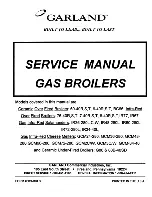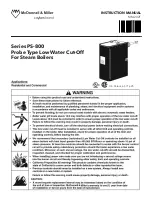
20
Figure 13 – Low Water Cut off Electrical Connections
4.12
RELIEF VALVE (shipped loose)
This appliance is supplied with a relief valve sized in
accordance with ASME Boiler and Pressure Vessel Code,
Section IV (“Heating Boilers”). The relief valve is to be
installed in the vertical position and mounted in the hot
water outlet. No valve is to be placed between the relief
valve, and the appliance. To prevent water damage, the
discharge from the relief valve shall be piped to a suitable
floor drain for disposal when relief occurs. No reducing
couplings or other restrictions shall be installed in the
discharge line. The discharge line shall allow complete
drainage of the valve and line. Relief valves should be
manually operated at least once a year.
CAUTION
Avoid contact with hot discharge water
4.13 CONDENSING
HEAT
RECOVERY
MODULE PIPING CONFIGURATIONS
Caution
: If isolation valves are provided on the CHRM, the
provision of a relief valve at the outlet of the secondary is
recommended .This valve is to be sized at minimum for
10% of the input of the appliance and is to be piped to drain
in a manner similar to the appliance relief valve.
4.13.1 CHRM IN SERIES WITH PRIMARY HEAT
EXCHANGER (INTEGRATED LOOP)
The supply water (Cold water) is pre-heated by CHRM and
fed into the outlet of the primary Heat Exchanger.
Provisions must be made to prevent cold water below
110ºF (44ºC) entering to the Primary Heat Exchanger.
BOILER APPLICATION (HYDRONIC HEATING)
In case of boilers (Hydronic heating boiler) application, the
return water (supply water) may be more than 110ºF
(44ºC), therefore there is no need for a recirculation loop
and the primary heat exchanger and CHRM can be piped in
parallel. Since the inlet water temperature to CHRM
exceeds 110ºF (44ºC) it will not condense fully and
therefore the CHRM will not perform to its maximum
efficiency capacity. If water colder than 110ºF (44ºC) is
available it can be fed to the CHRM.
WATER HEATER APPLICATION (HOT WATER SUPPLY)
In case of domestic water supply (Water Heating), the fresh
inlet water temperature will be less than 110 ºF (44 ºC), in
this case the CHRM may be fed directly with part of the
supply water using a secondary pump.
4.14
CIRCULATING PUMP SELECTION
The appliance has a low mass finned tube heat exchanger
for fast response and high heat absorption and employs
copper tubes for models DF-500 thru DF-3000 and copper
nickel tubes for models Df-3500 thru DF-5000, Selecting
the proper pump will ensure that temperature rise does not
exceed 35ºF (19ºC) and that heat exchanger tubes are not
prematurely scaled or eroded.
4.14.1
CIRCULATING PUMP OPERATION PRIMARY
HEAT EXCHANGER
MOST IMPORTANT
This appliance is designed for continuous pump operation
when the burner is firing. The circulating pump will run
continuously when the power switch is in the “ON” position.
As an optional feature a pump control system can be
provided. The pump control option allows the appliance
circulating pump to be cycled “ON” prior to the burner firing
and cycled “OFF” some time after the set point is satisfied.
The operation of the circulating pump is controlled by the
SmartFlame temperature control .When the appliance is
activated by a remote operating signal the pump will start
and run for the operating cycle and for a post purge period
based on temperature difference between inlet and outlet
connections to the appliance.
To select proper pump it is strongly recommended to
consider following:
•
Need to know the required flow (GPM) and pressure
drop for your appliance (see table 4 )
•
Type of application, hydronic heating or Domestic Hot
Water (DHW).
•
For hydronic heating and DHW applications with
normal water hardness choose a pump which will
result in a temperature rise across the main heat
exchanger of 30ºF to 35 ºF (17ºC-19ºC). If necessary
use a flow setter valve to achieve the desired
temperature rise.
•
For DHW applications with other than normal water
hardness choose a pump for the local water hardness
conditions. When hardness levels exceed 17 grains
per gallon consult factory for recommendations.
4.14.2
CIRCULATING PUMP SELECTION
CONDENSOR
The operation of the circulating pump may be continuous or
it may be in parallel with the main heat exchanger pump.
Size the secondary pump for a minimum flow of 10% of the
flow through the main heat exchanger and a maximum of
30% of the main heat exchanger flow up to 60 GPM.
Summary of Contents for DFH500
Page 31: ...28 PART 9 TROUBLE SHOOTING ...
Page 32: ...29 ...
Page 39: ...36 PART 12 EXPLODED VIEW ...
Page 40: ...37 ...
Page 41: ...38 ...
Page 46: ...43 PART 13 ELECTRICAL DIAGRAMS ...
Page 47: ...44 ...
Page 48: ...45 ...
Page 49: ...46 ...
Page 50: ...47 ...
Page 51: ...48 ...
















































